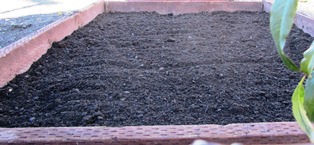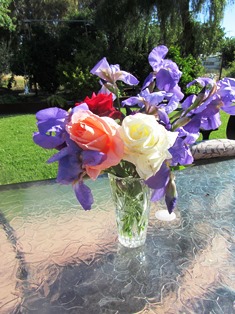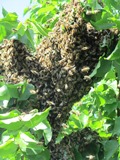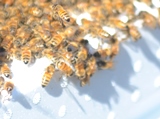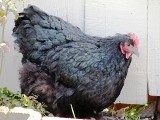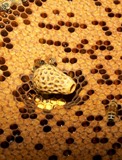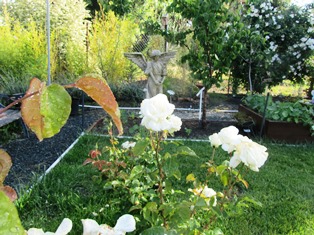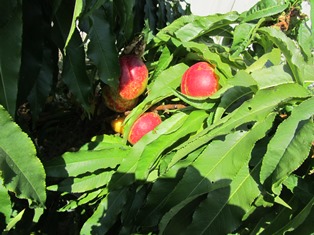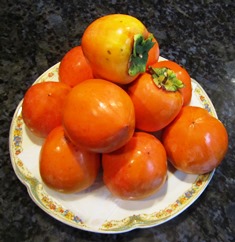Archive for the 'Gardening' Category
Divide Irises to Regenerate the Plant and Get Spectacular Blooms
Dividing the rhizomes of bearded iris plants is an easy and necessary process as the plant ages. The division process is best done during late summer or early fall, but we are doing this job now on our farmette.
The rhizome is a thick tuberous type of structure that sends up stems and leaves and also produces roots. Many gardeners divide their iris clumps every three to four years. Our beds of iris have become overcrowded with many new baby plants. It’s time to divide.
Before we move our iris from the side garden to planter boxes made of pressure-treated redwood, we prepare the soil in those boxes. We amend it with low-nitrogen fertilizer and compost.

These iris are planted too close–they will be replanted to 16 inches apart for air to circulate and for growing room
We cut back the foliage and pull off any of the sword-shaped leaves that have dried. Then we gently pull apart the new growth from the old clump. Pruning and cutting back the leaves helps ensure that pests do not overwinter.
The rhizome produces more rhizomes over time. Eventually the original rhizome will wither and die. Regularly dividing the clumps ensures new baby plants and blooms for years to come.
Less Mopping, More Writing
It may not be immediately apparent what recycled bricks have to do with writing, but bear with me. A friend who does professional demolition of houses and properties brought us a truckload of bricks from an owner who was re-landscaping his upscale property in a nearby East Bay city. Otherwise, those bricks were destined to be discarded in a landfill.
Temperatures hovered near 70 degrees Fahrenheit this past weekend (Thanksgiving) and the weather was perfect for us to lay a brick walkway. My architect husband and I are passionate about recycling materials that still have life in them. It’s one of the reasons why two of our favorite places to visit are architectural salvage yards in Berkeley: Ohmega and Urban Ore. See http://www.ohmegasalvage.com/ and also see http://UrbanOre.com/
With the rainy season on its way, it seemed like a good idea to lay the brick in a pattern along the northwestern side of the house where we keep the recycle and garbage bins. During winter, we track a lot of mud into our small farmette home because we have only dirt and gravel paths through the garden and orchard areas.
This year, it will be different. The newly laid brick walkway runs from the front to the rear of the house, joining the front porch (that we are currently building) with a gravel path leading to the property line. We laid out the brick pattern and tapped them close together, using a rubber mallet (since hitting brick on brick can cause breakage).
We still need to pour sand on top and sweep it into the cracks. But this kind of path can last for years. The ancient Romans built similar paths that remain to this day. The rains will come, but less mud will be tracked in because of the paving stones. That means for me fewer hours this winter spent mopping the mud tracked in and more time writing on my cozy mystery series.
Henny Penny Farmer’s Almanac–Sayings
Humans could learn a thing or two from the world of honeybees where all endeavor benefits the entire colony, not an individual bee.
A tea made of meadowsweet, chamomile, or peppermint herbs can calm an upset stomach.
To get stronger egg shells, feed your chickens extra calcium.
Producing manure is easy; it’s the moving of it that takes patience and the right shovel.
Sow above-ground plants during a waxing moon and below-ground plants during a waning moon.
The simplest treatment for a bee sting is to get the stinger out.
Move chickens and bees at night; when they awake in the morning, the move is a fait accompli.
If you enjoy listening to songbirds, it might interest you to know the male is generally the singer since he uses song to attract a mate and defend his territory.
Birds don’t just sing; they call, and their calls are how they communicate
with a partner or sound the alarm that a predator is near.
Box and jug wines are fine as long as you never drink or cook with a flawed wine.
Use a dab of raw honey or bee propolis to treat a peck wound on a chicken as honey and propolis have antiseptic, antibacterial properties.
Each nostril of a dog’s highly sensitive nose can separately track scents—a skill proving useful to humans in finding illegal drugs, locating dead bodies, and even detecting cancer.
Red wine remains drinkable for decades because the tannins act as a natural preservative; however, the wine must be properly bottled and stored.
If you want to lower your cholesterol, decrease your stress level
and improve your blood pressure, adopt a dog.
Pacific oysters can engage in annual sex reversals; male one year, female the next—one of nature’s many surprises.
Help your chickens go through the molting process (when they lose feathers and stop egg production) by feeding them 20 percent more protein and limiting their stressors.
Time spent in a garden is a lot like yoga; it slows the breath, quiets the mind, and lets you get to the truth.
To break your dog’s habit of licking you, get up and go into another room
immediately when the licking starts so the animal will associate its licking with your leaving.
If you don’t want to be devoured by insects, wear light colors when gardening.
If you want to strengthen your immune system, consume a teaspoonful of raw buckwheat honey every day.
A honeybee queens live 10 times longer than her worker bee sisters and while they are sterile, the queen remains reproductive throughout her life.
To keep your bee colony strong and robust, feed your honeybees when their food sources become scarce.
To make a fat-free broth, pour the juices of a roasted chicken or turkey into a wide-mouth jar and refrigerate until solidified; then, skim away the fat that has risen to the top.
You can’t shift the status quo if you don’t take action.
When relationships sour like beans and bitter herbs, an hour in a garden
can generate the sweetness of new dreams.
©November 2013 by Meera Lester
Permission is granted for use of individual quotes, provided the quoted material contains the following credit: “Used with permission from Henny Penny Farmers’ Almanac.”
Early December Farmette Chores
I arose early today as I have for the last few months, eager to greet the rising sun even as the days grow shorter as we head toward the winter solstice. I stand with eyes closed facing east until the light blazes against my lids, almost lighting my being from the inside. Then I say prayers–my way to start the day off right.
The fruit trees have changed leaf color and dropped most of their foliage. I helped them along today, collecting up all the fallen leaves and putting them in the green recycle bin. With the leaves gone, I can use an organic spray to prevent overwintering of fungi and pests. Similarly, I pluck the leaves from the tea roses and cut the canes to a height of between 12-18 inches.
With the spade, I turned the soil around the base of most of the fruit trees to aerate the soil in preparation for adding some amendments like compost. I twisted the remaining pumpkins off the vine and tossed the vines (which were still blooming and setting up fruit) into the compost pile. It’ll be freezing soon, so I’m just getting a head start.
I put food in all the bird feeders and hung some suet for the woodpeckers. Finally, I raked an area under the pepper tree for the new, smaller hen house that Carlos will build sometime this month since we plan to acquire some new chickens in January. In all, it has been a very productive day . . . one of many scheduled for this month, the last month of the year.
Fire Can Facilitate Germination of Redbud Tree Seeds
Seems strange that any plant seed could germinate by fire, but fire cracks the seed coat of the Western Redbud (Cercis occidentalis), permitting germination to occur. Redbud trees undergo rampant re-sprouting following a fire.
The Native Americans who favored the lovely red bark and straight new shoots of saplings for their basket weaving understood this. In fact, long before California was settled by European Americans, the Native American tradition was to selectively set fire to hillsides, canyon slopes, and dry river beds dotted with redbuds to stimulate a proliferation of new saplings.
Wondering how to germinate a redbud without fire, I conducted a little research and learned that if I poured boiling water over the seed (after removing it from the seed pod) and then allowing it to rest overnight before planting it in well-drained soil, it most likely would germinate. Once germinated, the young tree is relatively easy to grow. See http://plants.usda.gov/plantguide/pdf/cs_ceor9.pdf
It just so happens that behind the Henny Penny Farmette, a neighbor has several redbud trees that have dropped many pods in the last month or so. Last year, I tried transplanting a sprout or two without success. This winter, I’ll start from seed, but I think I’ll go the boiling water route to germination.
These trees are a sight to behold when they are in full bloom, around mid-March. The Western Redbud is also known as the California Redbud. There is an Eastern variety as well.
Fall Spraying for Peach Leaf Curl
Just beyond the sliding glass door of my kitchen, we’ve carved a bit of a lawn and garden out of a wild weedy field. When I’m washing dishes or making jam, I can see my garden sanctuary where I’ve moved in a statue of an angel and positioned a bench near two nectarine trees–a perfect place to sit and take in the view of Mount Diablo’s peaks.
Of late, though the nectarine trees look less than healthy. The two heavy-bearers have become infected with the fungus that causes peach leaf curl. It’s not just my trees that are infected; two of my neighbors have the same problem. And this showed up late in my trees this year.
I’ve tried plucking off the twisted and contorted leaves as they show, discarding them in the garbage (not the compost pile). However, I fear I am losing this battle. The trees are going through a leaf drop now that it’s middle of November. I don’t want that fungus overwintering in the infected leaves, so I’m gathering those into the garbage, too. And I’ll begin a spraying program.
The nectarines and peaches need to be sprayed three or four times (if we have a strong rainy season), from autumn to bud break in the spring. Both lime sulfur and copper sprays can be used; both are considered organic, although some formulations are not very strong. But the leaves must not remain on the ground under the trees.
Last year, I sprayed those trees the required number of times with an organic horticultural oil recommended by the local garden center. The trees were fine most of the summer. But last month, the infection showed up. And here I am now, plucking the leaves from the trees and picking them up from the ground.
I dare not use anything on treating the fungus that is not organic and safe for the honeybees. Come spring, perhaps I’ll be rewarded for my vigilance with new growth that is healthy and free of the fungus.
“Fruit of the Gods” Ready To Eat Now
If you love persimmons, it might interest you to know they are from a genus known by the Greeks as Diospyros kaki, “fruit of the gods.” But these sweet fruits must be fully ripened before consuming. The Fuju and Hachiya are the two main types grown in Northern California gardens. My favorite is the Hachiya; it has to be one of the most sensuous and luscious fruits on the planet to eat.
The Fuju fruit is more like an apple in shape and texture. You can differentiate it from the Hachiya because Fuju is squat and firm-fleshed, reddish yellow, and about the size of a baseball whereas the Hachiya fruit is pendulous-shaped, soft like an overripe plum, orange-scarlet in color, and about the size of a hefty apple or softball. Tamopan is a larger persimmon with a shape like a turban whereas Chocolate is so-named for its brown streaks; its flesh is quite sweet.
Persimmon trees look stunning in a garden, possessing outstanding ornamental qualities. They are relatively pest-free and produce consistently when mature. These small trees are easy to grow, have striking foliage and interesting branch structure, exposed after the leaves have fallen in autumn. They can even be espaliered against a frame or wall.
Hachiya persimmons are astringent on the tongue unless eaten when they are fully soft-ripe. Birds love them, too, so you have to pick them before they are pecked. Ripen in the kitchen before eating or cooking with them. If you want to dry persimmons, pick while the fruit is still firm and with some stem. Tie a string around the stem and hang in the sun until the fruit becomes dried. It will taste something like a high-quality prune or lichti.
Saving Seed for Future Generations
I spent the morning looking through Seed Savers Exchange’s online offerings. If you haven’t heard of the Seed Savers Exchange (SSE), the nonprofit organization based in Decorah, Iowa that works to preserve “our gardening heritage,” then I urge you to check it out. See http://www.seedsavers.org/About-Us/Mission/
What really got me excited was SSE’s “Slow Food U.S. Ark of Taste.” It’s a catalog listing over 200 foods in danger of becoming extinct, including varieties of beans, tomatoes, lettuces, squash, corn, and peppers.
I’m interested in growing some of the old varieties of heirloom beans, for example, the Turkey Craw bean, from Virginia, North Carolina, and Tennessee. The original bean seed was said to have been discovered in that part of the United States in a turkey’s craw.
I also want to plant the bean known as Jacob’s Cattle. Originally the Passamaquoddy Indians in Maine grew this bean. Apparently once New Englanders discovered its excellent taste, the bean became a favorite in their baked beans and chili dishes.
We live in an age when our culture’s emphasis is on fast and faster. But we’ve seen the consequences of fast food on our country’s obesity epidemic. When it comes to delicious, wholesome, and healthy, fast food may not be so good for us and our children.
The seeds from Seed Savers Slow Food U.S. Ark deserve to be saved. What we save now can be passed to the next generation for safekeeping, ensuring, among other things, that Earth’s biodiversity is preserved for all generations. See, http://www.seedsavers.org/
Herbs to Flatter Vegetables, Flavor Meat, and Finesse Fertility

If you have limited space, use taller herbs like this lavender in your landscape and gr0w smaller plants like mint in pots
Herb gardens have always held a fascination for me. One of the many reasons I love growing herbs is the scent that many herbs release with bruising that can occur when you brush against plants such as bee balm, rosemary, or lavender.
Most herbs contain fragrant oils (verbena and lavender, for example) that are frequently used in the making of cosmetics. Many herbs reseed themselves, ensuring a perennial supply for medicinal and culinary uses.
For thousands of years, herbs have been added to food to enhance the flavors. In fact, many cuisines of the world are distinctly identifiable from herbs and mixtures of them added to the food. Imagine Italian marinara without the addition of basil in the tomato sauce; a French meat or vegetable dish without savory, fennel, sorrel, rosemary, or tarragon; or an English traditional dish without bay leaf, marjoram, garlic, or mint. Consider Greek food without rosemary, thyme, or arugula.
Herbs have been used to flavor vinegar, olive oil, and liqueur. Herbs even play a role in amorous arousal. In France, Verveine du Velay is a vervain-flavored liquer popular in Le Puy. It’s reputation is further enhanced by the popular ages-old perception of it as an aphrodisiac. According to author Jade Britton (The Herbal Healing Bible, Chartwell Books, Inc.), the herbs Siberian ginseng, damiana, and saw palmetto have been used in remedies to treat male infertility along with gingko for increased blood supply to the male sex organ. See, http://www.amazon.com/The-Herbal-Healing-Bible-Traditional/dp/0785829652
While many herbs thrive in well-drained, sunny positions in the garden, others do equally well in part sun/shade. For shade-tolerant herbs, plant the following.
Chives
Cilantro/Coriander
Garlic
Lovage
Lemon Balm
Mint
Oregano
Parsley
Sweet Woodruff
Thyme
You can grow herbs in a pot, a coffee can, a half wine barrel, window box, even an old wheel barrow. The point is that herbs are not too fussy. Some are so vigorous as to be considered invasive (mint, for example). So whether you seek the enhance the flavor of food, add pizazz to a meat dish, or to increase your stamina, libido, and overall health, maybe it’s time to plant your own herb garden and see what herbs can do for you.
Don’t Put Away Your Gardening Gloves and Trowel Just Yet

Red pomegranates hang like jewels in contrast to the lush green leaves that will soon turn yellow and drop
Autumn has a arrived. The fruit and nut trees are shedding leaves and preparing for winter dormancy. Pumpkins are taking center stage for harvest festivals and Halloween decorations. Apples have been gathered are are being peeled and cored for pies and cider making.
If you are thinking about putting away your gardening gloves and stashing your trowel and wheelbarrow, hold on a minute. It’s possible to extend the growing season from summer into autumn and even later . . . by taking a few precautions.
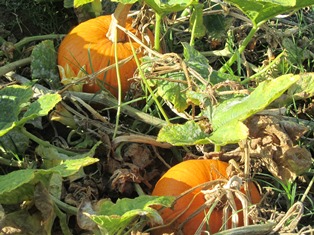
Pumpkins in my garden sport golden shades of orange and yellow, signalling arrival of the cool season
As the sun slants lower in the sky giving us shorter days, less light, and fewer hours to garden, there are some plants that will grow just fine during the cool days of fall.
However, you must select the right plants for the cool season. In addition, you’ll increase your plants’ survival rate by growing them in raised beds and boxes with good soil and aged manure. Wet them well if a cold front comes through (it’s counter-intuitive but moisture will protect their roots). Keep them warm at night with plant covers that you take off during the day when they can make the most of the sun’s warmth and light.
Consider growing some of these cool season crops: beet, bok choy, broccoli, bulb onion, chard, fava bean, garlic, green onion, kale, kohlrabi, lettuce, radish, spinach, and turnip. I’ve found many of these plants available at my local DIY garden center during the past two weeks.
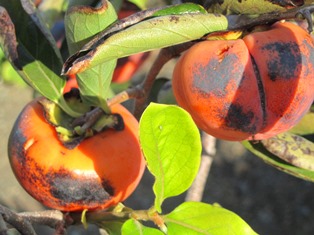
Coffee Cake, a new variety of Fuyu persimmon I’m growing will soon be ripe for picking, slicing, and serving
For November, depending on weather conditions in local microclimates, Northern California gardeners can grow fava bean, garlic, greens, leek, lettuce, onion, pea, radish, and spinach as well as some perennial herbs, especially in boxes and/or pots on the patio or in protected places such as porches.

My pumpkin vines, over 25 feet long, still have numerous blooms and lemon-size green pumpkins hanging on
Because of Northern California’s mild Mediterranean climate, gardeners can enjoy cultivating plants from spring through the fall, not just during our hot summer months. If it gets too chilly for the poor honeybees to pollinate, get yourself a soft watercolor brush and do the pollination yourself.
Finally, it’s worth noting that during our rainy season, the water for the garden falls from the sky rather than from the hose. One of the many reasons not to put away the garden tools just yet.
 Facebook
Facebook Goodreads
Goodreads LinkedIn
LinkedIn Meera Lester
Meera Lester Twitter
Twitter




